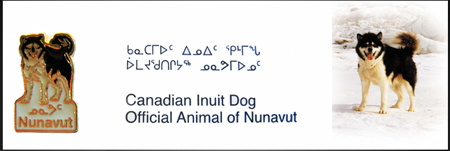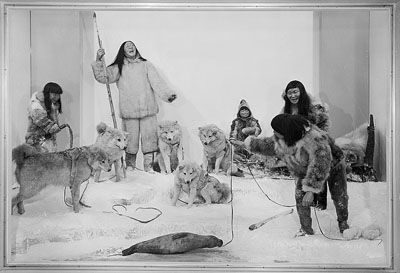From the Editor: Fed Up!
IsumaTV’s First Annual Online Film Festival
Paving over Cultural Identity
Retracing Twenty-Five Year Old Foot and Paw Steps
Okpik’s Dream Update
Bannock – On the Frozen Sea, in the Woods or at Home
Media Review: Romance of the Far Fur Country
Media Review: On the Trail of the Far Fur Country
IMHO: Truth, History and Dogs
Navigating This Site
Index of articles by subject
Index of back issues by volume number
Search The Fan Hitch
Articles to download and print
Ordering Ken MacRury's Thesis
Our comprehensive list of resources
Defining the Inuit Dog
Talk to The Fan Hitch
The Fan Hitch home page
Editor: Sue Hamilton
Webmaster: Mark Hamilton
The Fan Hitch, Journal
of the Inuit Sled Dog, is published four
times a year. It is available at no cost
online at: https://thefanhitch.org.
The Fan Hitch welcomes your letters, stories, comments and suggestions. The editorial staff reserves the right to edit submissions used for publication.
Contents of The Fan Hitch are protected by international copyright laws. No photo, drawing or text may be reproduced in any form without written consent. Webmasters please note: written consent is necessary before linking this site to yours! Please forward requests to Sue Hamilton, 55 Town Line Rd., Harwinton, Connecticut 06791, USA or mail@thefanhitch.org.
This site is dedicated to the Inuit Dog as well as related Inuit culture and traditions. It is also home to The Fan Hitch, Journal of the Inuit Sled Dog.
The Fan Hitch welcomes your letters, stories, comments and suggestions. The editorial staff reserves the right to edit submissions used for publication.
Contents of The Fan Hitch are protected by international copyright laws. No photo, drawing or text may be reproduced in any form without written consent. Webmasters please note: written consent is necessary before linking this site to yours! Please forward requests to Sue Hamilton, 55 Town Line Rd., Harwinton, Connecticut 06791, USA or mail@thefanhitch.org.
This site is dedicated to the Inuit Dog as well as related Inuit culture and traditions. It is also home to The Fan Hitch, Journal of the Inuit Sled Dog.

A dog from Iqaluit was chosen to represent Nunavut’s Official Animal.
Paving Over Cultural Identity
by Sue Hamilton
A January 9, 2015 Nunatsiaq News headline thundered across my computer monitor: “Iqaluit sled dog owners lose winter lot to asphalt plant – Nunavut government erases city’s hollow promise to designate lot”. Ten dog team owners who have been using the land adjacent to the airport known as the West 40 have been told they must leave this winter picketing area, some by June 1, 2015, the rest soon after that. The land is owned by the Government of Nunavut (GN) but is set to be turned over to the city of Iqaluit, Nunavut’s capital. The plan is to establish a second asphalt plant (another already exists elsewhere in the community) on the site for paving of airport runways, access areas and other city paving projects.
Approximately six years before the birth of Nunavut, Iqaluit dog team owners were told that land would be set aside for sled dogs, even on land not belonging to the town. According to the Nunatsiaq News story, “Dog team owners set up shop on the land around 1994, based on a promise from the city that it would somehow acquire the land, and reserve it for dog teams…The city never delivered on that promise.”
Dog team owners are seeking, and have been for a very long time, to have the city and GN officially designate a secure and suitable area specifically for picketing dog teams. But this has been an ongoing problem which the powers-that-be have managed to weasel out of resolving for decades. And it appears to this writer that any purported assurances on the part of the two governments to ultimately settle this long-standing matter will continue to be unfulfilled (In the rare responses I have received to letters sent to either the Iqaluit City Council or the Nunavut Legislative Assembly about various working dog issues, one government has insisted that it is the other government’s responsibility to address.) My impression is that both Iqaluit and GN would prefer this issue just quietly disappear along with the dog teams themselves, making the year 2000 designation of the Canadian Inuit Dog/Qimmiq as the new territory’s Official Animal all that much more puzzling and outright hypocritical.
In the January 20, 2015 edition of Maclean’s, “Move over, mushers: A battle brews over sled dog parking in Iqaluit – A plan to take away Iqaluit’s only prime sled dog lot has mushers up in arms and fearing for their future”, the article’s author, Martin Patriquin, says “the political will” to resolve this issue is unclear. But a comment by Iqaluit’s acting chief administrative officer, John Mabberi-Mudonyi, leaves little doubt:
“Is the city going to offer land? I don’t know…That will be a decision of council. They’ve been squatting on that land. Historically, when it comes to sled dogs, everyone thinks of the North. Yes, it’s important to the image of Iqaluit, but should we jump just because [dog owners] want this?”This stunningly dismissive and insensitive statement smacks of the same attitude demonstrated by early explorers and traders; the colonialist government which separated children from their families and thrust them into residential schools; and in the mid-20th century dog slaughter. The dog owners of whom Mabberi-Mudonyi inarticulately speaks, instead of being denigrated as “squatters”, should be lauded and supported for their efforts and commitment to keep millennia-old dog teaming practices alive as best they can, struggling without help/support/protection of their efforts to maintain/sustain these aboriginal landrace dogs, a living symbol of Inuit culture and tradition. It is most fortunate that other non-native residents who have come to call arctic Canada their home don’t feel as Mabberi-Mudonyi apparently does.
One Iqaluit dog team owner has opined, “We are more than a bunch of individuals with a recreational activity. The breeding stock in Iqaluit contributes greatly to maintaining this ancient aboriginal landrace as a working animal in the arctic as it is the only way characteristics important to being a real working animal will be preserved. How else will one select to breed dogs who keep well in harsh conditions, have a good and happy work ethic, trustworthy temperament, are able to live for weeks on the trail if one is not doing those things with these dogs? And it is important to remember that the dogs from Iqaluit continue to be selected, bred, trained and used for long distance, multi-week, ‘freight’ expeditions such as travelling the high arctic archipelago or between Kimmirut and Iqaluit or Iqaluit to Pond Inlet…all this in addition to team owners’ one and two week ‘annual vacations’ have contributed to the revival of dog teaming not only in Iqaluit, but also elsewhere in the Canadian North, Nunavik in particular. The city of Iqaluit and Government of Nunavut need to acknowledge with very positive actions that the dogs have value beyond us "squatters"…!”
Dog sledding eco-tourists scenes in Iqaluit and around the Canadian North are common images actively promoted by Nunavut Tourism and other outfitting sites. How can this continue with Iqaluit’s not-in-my-backyard attitude?
Another musher commented for the Maclean’s article, “If it becomes too much harder to have dog teams, people are just going to give up, and it’ll die off.” Could that be that what the “rulers” of Iqaluit’s city and territorial governments are hoping for?
How can the future of these dogs, part of the very foundation of Inuit civilization be sustained without a resounding and proactive affirmation of their worth?
Iqaluit dog team owners are not fading away quietly into the night however. This month, one has written a forthright and well-reasoned letter to the Nunavut Impact Review Board (NIRB). According to their website, the NIRB’s responsibilities are to assess “…the potential impacts of proposed projects before any required permits, licences and approvals can be granted. The NIRB’s mission is to protect and promote the well-being of the Environment and Nunavummiut through the impact assessment process”. In it the letter’s author describes the asphalt plant project as being “… on a fast track (i.e. word started to circulate this autumn past, when heavy equipment was driven through dog team lines and a stockpile of barrels full of asphalt appeared) and through informal discussions, it has been indicated that the project will commence in June 2015. However, no official written information (or even posted signs on the site) have been provided to the public or to directly affected individuals.” S/he further inquires, “…if it turns out that the proponent has not met regulatory requirements, what would be the process for informing them and ensuring the requirements are met prior to further project construction activities taking place?” The letter goes on to express concern regarding the asphalt plant project’s environmental impact, its lack of total transparency and, in a timely manner, residents’ right to have their concerns aired and their questions answered in order to be completely informed regarding any and all social-cultural as well as toxic menaces, given its proximity to waterways. Many are eagerly looking forward to the response to the NIRB inquiry.
In both distance and time, the contributions of Iqaluit dog team owners and their dogs extend far beyond Iqaluit city limits and Nunavut’s territorial borders. Not only have dog men and women elsewhere in the Canadian North greatly benefited from the incorporation of quality Iqaluit Inuit Dog DNA to re-establish the authentic aboriginal landrace nearly extirpated as a result of the dog slaughter and other causes of their disappearance from the land of their birth. It is quite reasonable to include authors, educators, scientists, historians, cynologists, filmmakers, tourists and folks like my husband and I who have given homes to “arctic retirees” which, in turn have inspired us to learn about Inuit culture, traditions and the challenges to aboriginal dogs worldwide. Everyone who may see themselves in these or other categories should be outraged and ought to be inspired to step up and speak out in defense of dog team owners and traditional Inuit Dogs in Iqaluit and elsewhere in the North for that matter. Visit the City of Iqaluit and Government of Nunavut websites for contact information.
“The only thing necessary for the
triumph of evil
is for good men to do nothing.”
Edmund Burke (1729 –1797)
Irish political philosopher, Whig politician, statesman
is for good men to do nothing.”
Edmund Burke (1729 –1797)
Irish political philosopher, Whig politician, statesman
What is happening now in Iqaluit, and other unresolved working dog related issues still festering there, may be symptomatic and symbolic of the mindset elsewhere in Canada’s Arctic as well…a bellwether perhaps of what is to come, forsaking the past for something called “the future”. Back in 1970 singer-songwriter Joni Mitchell recorded Big Yellow Taxi that turned out to be a hit in her native Canada. Played to this day on classic rock ‘n roll stations, the lyrics still resonate forty-five years later:
They took all the trees, and put em
in a tree museum
And they charged the people a dollar and a half to see them.
Don't it always seem to go
That you don't know what you got 'til it's gone
They paved paradise and put up a parking lot.
And they charged the people a dollar and a half to see them.
Don't it always seem to go
That you don't know what you got 'til it's gone
They paved paradise and put up a parking lot.
Substitute Inuit Dogs for trees in a tree museum and eventually here may be the only places where people can see Nunavut’s Official Animal:

1957 anthropology diorama of a life group from the arctic region,
it formed part of the "Native Peoples of the Americas" exhibit.
National Museum of Natural History, Historic Images
Collection of the Smithsonian Institution Archives.